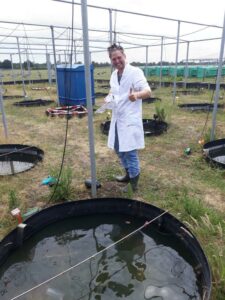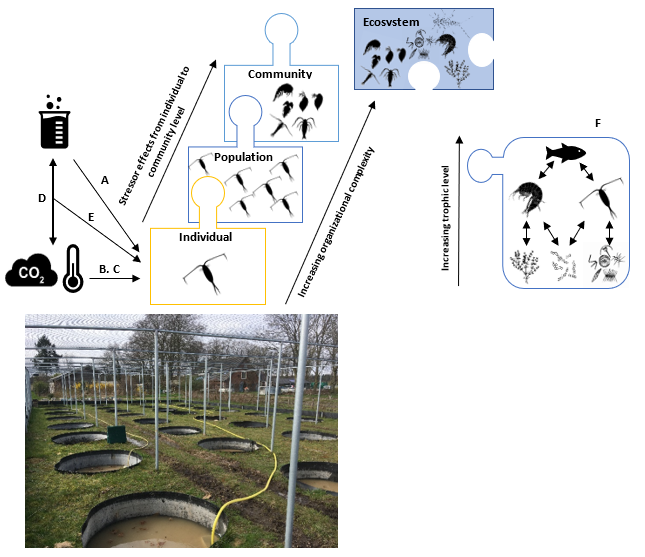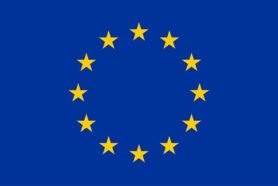WP5: Effects
ESR contributionsCombined effects of stress posed by global climate change and chemicals on aquatic ecosystemsFreshwater ecosystems may be affected by direct and indirect alterations of temperature and partial pressure of CO2 among other environmental variables associated with a global changing climate, henceforth Global Climate Change (GCC). Next to increasing mean temperatures, increased severity and frequency of extreme weather events, including heatwaves and warm spells are coherent findings for the end of this century. In addition to these natural, GCC-induced effects on aquatic ecosystems, variables like temperature can also interact with other existing anthropogenic stressors, such as chemicals. Modified temperature regimes are expected to modify the environmental fate of these compounds e.g. through manipulated compound properties. Today, the joint effects of non-chemical GCC-related stressors (i.e. temperature, CO2) and chemicals on freshwater ecosystems continue to be understudied. Multiple stressor studies observe mostly effects on single species but population or community-level approaches that include ecological complexity and reality are rather rare. We are interested in the effects of chemicals in the aqueous environment facing GCC. In our approach, we want to consider current and future temperature variability (i.e. daily temperature fluctuations) and extreme events instead of constant temperature regimes by applying the innovative transportable temperature and heat wave control engine (TENTACLE). Outdoor- and indoor-cosms together with the applied TENTACLE in distinct study regions of ECORISK2050 include high environmental realism and will provide new scientific insights and a better understanding of chemical effects on aquatic ecosystems within Europe in the light of GCC. 


Establishing relationships between biological community composition and vulnerability to chemicalI am Francesco Polazzo, born in Italy and now placed in Spain at the IMDEA Water Institute (Alcalà de Henares, Madrid). During my PhD project I will be studying how chemical pollution together with Global Change related variables (temperature, eutrophication, hydrological fluctuations) impact freshwater communities and populations. I will do so by performing several micro- and mesocosm experiments, simulating lotic as well as lentic ecosystems. Using chemical activity to understand effects of chemical mixtures on microbial communities in aquatic sedimentsOrganic chemical substances occurring in various mixture combinations are ubiquitous in the environment. Whereas most environmental assessments focus mainly on single compound´s effects which have been studied intensively, assessment methods of detecting impacts and risks of chemical mixtures in aquatic systems are still scarce [1]. The lack of knowledge is mainly due to the facts that it is 1) impossible to measure all chemicals´ concentrations in the environment due to technical limitations and costs, and 2) measuring all concentrations does not supply any information about the total concentration of mixtures, as concentrations are compound-specific and cannot be added up. Under these circumstances, risk and exposure assessment of toxic chemicals in the environment are exceedingly demanding [2]. The “chemical activity” approach provides a solution to master these confinements for chemical mixtures that are below their specific toxic concentration, by construing the concentration of various chemicals into a common, unitless currency [2]. We will expose Daphnia magna and microbial communities to chemical mixtures to understand how the concept of chemical activity can be used to assess chemical mixtures and therefore, help provide a new framework to evaluate chemical mixtures in areas with no point sources. References Modelling the interaction between climate change and chemical effects at different levels of biological organizationThe future perspective of climate change demands an update for chemical risk assessment and highlights the urgent need to understand the effects caused by multiple stressors. In this research, effect mechanisms of chemicals and global climate change-related stressors will be investigated at different levels of biological organization (e.g., individual, population, community) of freshwater ecosystems. Starting with a literature review on both, experimental and modelling assessments, we will gather state-of-the-art data and methods studying the combined effects of temperature and chemicals in freshwater systems to inform subsequent investigations. To update effect modelling at the individual level, we will extend existing toxicokinetic-toxicodynamic modelling frameworks (e.g., GUTS1 and DEBtox2) with the ability to assess combined effects of pesticides and temperature for freshwater invertebrates. Subsequently, we will translate these individual responses to population and community levels using individual based models, like ChimERA3. For proper calibration and validation of these modelling exercises, we will use existing data gathered in the literature review, exposure studies conducted as part of this PhD project, as well as data produced in mesocosm experiments performed by researchers from the ECORISK2050 project. Additionally, theoretical modelling approaches will be explored, to investigate the role of intra- and inter-species relationships in the response to environmental changes at higher levels of biological organization. Finally, this research aims to support future ecological risk assessment with the development of advanced modelling tools enabling realistic assessment of combined effects of chemicals and global climate change on freshwater ecosystems in the future. [1] General Unified Threshold Model of Survival[2] Dynamic Energy Budget Theory [3] De Laender, F. et al 2014. The ChimERA project: coupling mechanistic exposure and effect models into an integrated platform for ecological risk assessment. Environ Sci Pollut Res 21, 6263–6267 Objectives5.1. Assess and compare the sensitivity and vulnerability of aquatic populations and communities to GC and chemical pollution under different geographical and biological (community composition) scenarios. 5.2. Quantify the impacts of chemicals on key ecological functions. 5.3. Develop a set of validated in silico tools to evaluate the effects of the chemicals at different levels of biological organization. |
||
Description of Work and Role of Specific Beneficiaries / Partner OrganisationsIn this WP we will assess the vulnerability and resilience of aquatic ecosystems to chemical pollution under future environmental change scenarios and develop conceptual and modelling frameworks to improve the effect assessment of chemicals. Experimental research into the effects of chemicals on aquatic populations and communities will be performed by WU, IMDEA and SU by selecting relevant combination of stress factors (as highlighted by WP3), while WU will be involved in the development, parameterization and validation of ecological models. WU will assess the sensitivity of aquatic communities to increasing temperatures and CO2 conditions in different geographical regions of the EU. IMDEA will assess how different climate-related factors affect the vulnerability of aquatic communities to future chemical contamination and propose a framework to establish relationships between varying community composition and responses to chemical pollution. SU will evaluate the resilience of microbial communities to chemical pollution, define chemical impacts on key ecological functions, explore tipping points and define ecosystem pollution tolerance limits. Finally, WU will develop a set of modelling tools to assess the influence of GC on ecosystem function and structure and its interaction with chemical stress at different levels of biological organization (individual, population, community, and ecosystem). The parameterization and validation of the models will be carried our using the data obtained from the different experiments performed by WU, IMDEA and SU. Finally the ecological framework and modelling tools developed by this WP will be integrated into WP5 to develop improved risk assessment and mitigation approaches. |
||
Working Package Deliverables5.1 Comparison of sensitivity and vulnerability to climate change and chemical stress in different geographical regions 5.2 New Framework for evaluating the influence of community structure and global change on the vulnerability to chemicals 5.3 EU-level chemical vulnerability maps and scenarios 5.4 New framework for assessing the resilience of microbial communities to chemical stress 5.5 Determination of the chemical effects on microbial ecological functions and chemical tolerance limits 5.6 New Modelling framework for assessing the combined effects of chemical and GC stressors 5.7 Set of validated ecological models for assessing the combined effects of GC and chemical stress |

 This project received funding
from the EU Horizon 2020 program
under Marie Sklodowska-Curie
grant agreement No 813124
This project received funding
from the EU Horizon 2020 program
under Marie Sklodowska-Curie
grant agreement No 813124


